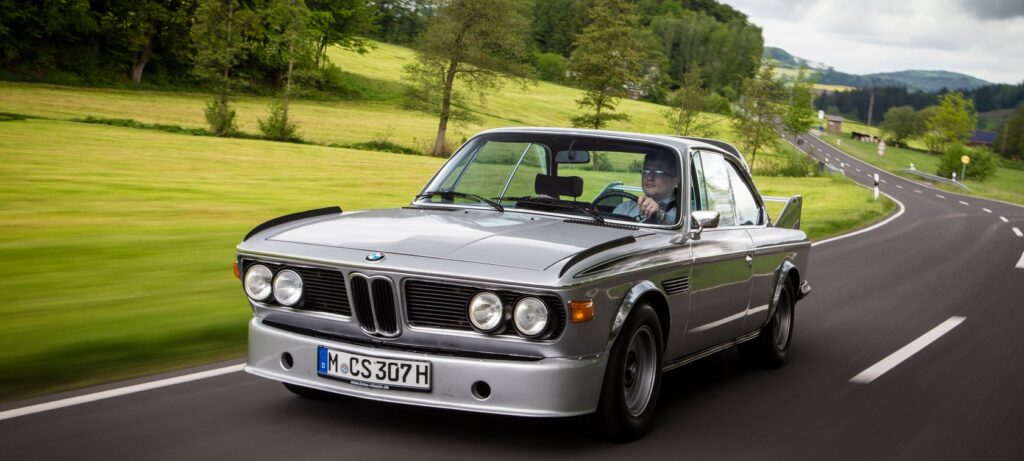
The BMW 3.0CSL, often referred to as the “Batmobile,” is a legendary sports coupe that holds a prominent place in automotive history. Introduced in 1971, the 3.0CSL represents the pinnacle of BMW’s engineering prowess and motorsport achievements.
At the heart of the 3.0CSL’s creation were a team of talented designers and engineers led by Wilhelm Hofmeister. Hofmeister, the head of BMW’s design department at the time, played a crucial role in shaping the iconic look of the 3.0CSL. He incorporated aerodynamic features into the car’s design, such as the distinctive front air dam, rear spoiler, and the now-famous large rear wing. These elements not only enhanced the car’s performance but also gave it a striking and aggressive appearance.
In addition to Hofmeister, the 3.0CSL’s design was influenced by the renowned Italian coachbuilder, Bertone. Marcello Gandini, a designer at Bertone, was responsible for penning the sleek and angular lines of the 3.0CSL’s body. His expertise in aerodynamics and his avant-garde design approach helped create a car that was both visually stunning and technologically advanced.
Under the hood, the 3.0CSL featured a powerful inline-six engine with a displacement of 3.0 liters. This engine was equipped with fuel injection and produced an impressive output of up to 206 horsepower, depending on the specific variant. Combined with the car’s lightweight construction and aerodynamic enhancements, the 3.0CSL offered exhilarating performance and precise handling.
The motorsport legacy of the 3.0CSL is equally remarkable. BMW recognized the potential of the car in racing and developed a competition version known as the 3.0CSL “Batmobile.” This track-focused variant featured further weight reduction, improved aerodynamics, and increased engine power. The 3.0CSL Batmobile quickly established itself as a dominant force in motorsport, achieving numerous victories and championship titles.
One of the most notable achievements of the 3.0CSL came in the European Touring Car Championship (ETCC). In 1973, the BMW 3.0CSL secured the overall victory in the championship, marking the beginning of BMW’s motorsport success and establishing the car as an icon of racing. The 3.0CSL’s success continued in subsequent years, cementing its reputation as one of the most successful touring cars of its time.
The BMW 3.0CSL’s impact extended beyond the racetrack. It became a symbol of BMW’s commitment to performance and motorsport excellence, elevating the brand’s image and attracting a passionate following of enthusiasts. Its success in motorsport not only bolstered BMW’s reputation but also influenced the development of future high-performance models.
Today, the BMW 3.0CSL is highly sought after by collectors and car enthusiasts worldwide. Its combination of striking design, exceptional performance, and motorsport pedigree has secured its place in automotive history. The 3.0CSL remains a timeless icon that represents the pinnacle of BMW’s engineering achievements and serves as a reminder of the brand’s commitment to pushing the boundaries of automotive innovation.
In addition to its racing success, the 3.0CSL made significant contributions to BMW’s overall brand image and marketing efforts. The car’s aggressive and aerodynamic design, coupled with its impressive performance capabilities, helped BMW establish a reputation for building high-performance vehicles. The success of the 3.0CSL on the racetrack translated into increased interest and sales for BMW’s road cars, as consumers were drawn to the brand’s motorsport heritage and the association with the legendary “Batmobile.”
The 3.0CSL’s impact extended beyond the track and showroom floor. It became an icon of automotive design and engineering, inspiring future generations of BMW vehicles. Its sleek lines, muscular stance, and bold features set a new standard for sports cars, and many of its design elements can be seen in modern BMW models. The iconic “Batmobile” rear wing, in particular, has become synonymous with the BMW brand and is often incorporated in contemporary designs as a tribute to the 3.0CSL’s racing heritage.
The BMW 3.0CSL’s influence in motorsports can still be felt today. It paved the way for BMW’s continued success in touring car championships and endurance racing. The lessons learned from the development and racing of the 3.0CSL helped shape BMW’s future motorsport programs, resulting in numerous victories and championships across various racing series.
In conclusion, the BMW 3.0CSL is a true automotive icon. Its distinctive design, impressive performance, and motorsport success have solidified its place in history. The collaboration between BMW’s talented designers and engineers, led by Wilhelm Hofmeister, created a car that continues to captivate enthusiasts and inspire automotive enthusiasts to this day. Whether on the road or the racetrack, the BMW 3.0CSL remains a symbol of engineering excellence and a testament to BMW’s commitment to pushing the boundaries of performance and design.
